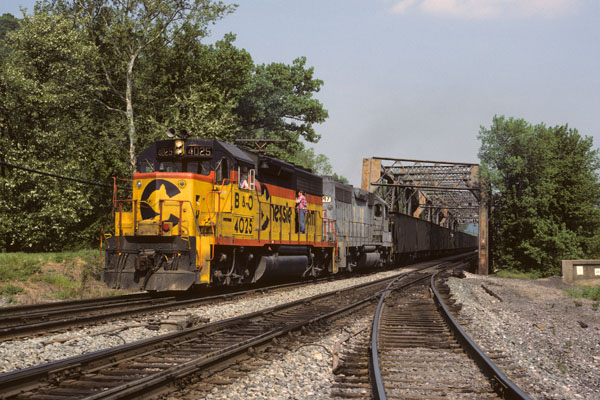St Alban Media, LLC
cno@stalbanmedia.com
Part 3. Across the Mountain State
Content of page 112 of my C&O by Steve Fuchs with Rick Acton , Jr.
Rick Acton, Jr.
Blast from the past May 1987
A C&O eastbound hopper train leaves Huntington terminal crossing the Guyandotte River
near mile 501. After losing its B&O parent one month earlier, the lead EMD GP40 appears
threatening to go off duty as it becomes evident it won’t be heading up former home rails.
Guyandotte
When Robert Young relinquished control of C&O in 1954 to head the New York Central, new chairman Cyrus Eaton retained president Walter Tuohy, and they managed to win control of B&O in 1963. Although B&O needed cash, C&O didn’t, so changes could be planned in a deliberate manner not disruptive of service—unlike, for example, as occurred with Erie and Lackawanna in 1961 and Pennsylvania and New York Central in 1968, where partners were hurried and harried to recreate a bottom line. In 1965, a connection was installed at the east bank of the Guyandotte River to tie B&O’s Ohio River line from Parkersburg to C&O facilities we’ve already seen, allowing abandonment of the parallel B&O track west to Kenova.
At a foggy dawn of October 2006, Q317 (Cumberland to Huntington) rounds the bend near
Ohio River sub mile 211 approaching the switch at Guyandotte. This area is the oldest part
of Huntington and pre-dates arrival of C&O, which ultimately created Huntington as a railroad town. Paired B&O freights switched industry along the Ohio River sub for many decades,
becoming joint trains with C&O starting with OV33/34 in the mid-1980s. The western terminal has varied between Huntington, Cincinnati, and Russell and the eastern terminal, between Pittsburgh, Parkersburg, and Cumberland yet the basic function is the same. Although its
present routing is to Huntington, this Q317 will soon be ferried on to Russell as local H799.
112

